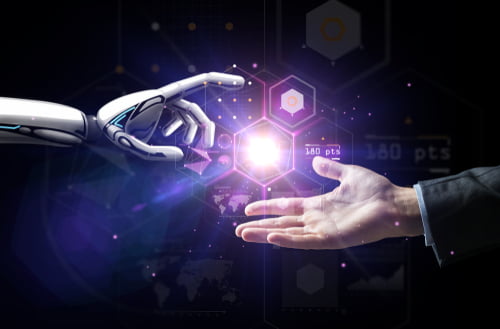Science is proving that AI and Man can merge, but would that relationship be one of strength? Is AI a threat to man or an opportunity to cherish?
These are not easy questions. Humanity is at the start of that journey, but there are interesting takeaways from progress already made.
Entangling man and machine
Baidu Research believes humans will eventually morph and transition into Avatar-like or cyborg-like creatures where AI could replace or replicate human senses. Extended reality would replace reality. The virtual world will be the marketplace for a decentralized digital economy that will chip away at the real economy.
Smart chips that augment us
Can a human-machine cyborg union launch humanity into the era of Human 2.0?
Elon Musk’s computer-brain interface startup Neuralink has started clinical trials on placing smart chips in brains.
Musk publicly predicted that his company’s launch product “will enable someone with paralysis to use a smartphone with their mind faster than someone using thumbs.”
He recently stated that these implants could allow tetraplegic people to walk.
Neuralink transplanted AI microchips in the brains of a monkey and pig, paving the way for trials with humans, according to The Guardian.
What this means is that humans can effectively start controlling computers with their minds via surgically implanted electrodes or chips.
And technology is good at allowing us to connect remotely with others as well. These smart chips could one day send brain waves in hybrid cyberspace that could reach anyone, anywhere.
Will we then need a human firewall so that we maintain control of our thoughts and prevent others from hacking them?

“Mind-bending” developments
Human-computer interaction (HCI) was research that started in the 1980s and is now more aptly known as neuromorphic computing.
The technology aims at integrating systems containing electronic analog circuits that imitate neuro-biological architectures that exist in biological nervous systems.
Recently, Columbia University mixed together brain implants, AI, and a speech synthesizer to translate brain activity into recognizable robotic words. The brain can now talk to us.
Science believes that the human brain-machine interface could provide people with immediate access to global human knowledge on the cloud and significantly improve learning capacities and intelligence.
Human-Machine Biology
The body is becoming an experimental field for a range of new technology and biological applications, all in the name of medical science.
These include genome sequencing and gene editing, cellular implants, and embedded wearables residing in our bodies.
Scientists are now launching a war on bacteria by unleashing nano-scale bots that act like “smart bombs.”
Additionally, there are ongoing discussions among scientific research circles to implant bionic eyes and bionic kidneys, or 3D printed human organs.
Biocomputers
Biocomputers could, one day, store data on the DNA of living cells, including those belonging to humans. DNA is already being tested as a medium for storing information, replacing antiquated methods like CDs and DVDs.
This technology could allow biocomputers to perform complex calculations way beyond human’s current abilities.
Already, researchers at the Technion have put together a complex biocomputer, a programmed biological system that fulfills complex tasks.
Machines replace people
Robots, not cyborgs, are becoming an indispensable tool supporting logistics, manufacturing, materials handling, inspection, healthcare construction, and food delivery.
Wendy Tan White, CEO at Intrinsic, said: “We’re on the cusp of an industrial robotics renaissance, driven by software-first solutions, cheaper sensing, and more abundant data.”
Autonomous robots can one day be capable of complex real-world interaction and lead to the displacement or replacement of the human workforce.
We could be creating an intelligent monster that might prove relentless in the pursuit of its independence from humans. Or we could be empowering a smart new world that overcomes instead of succumbs to our frailties.
We just don’t know.








